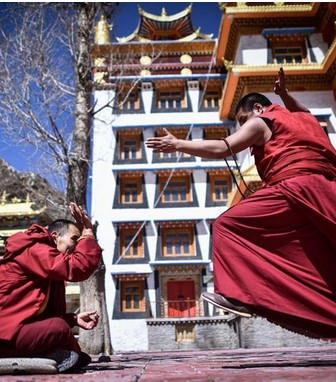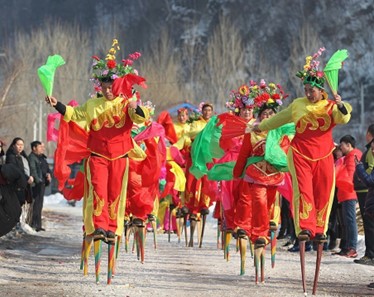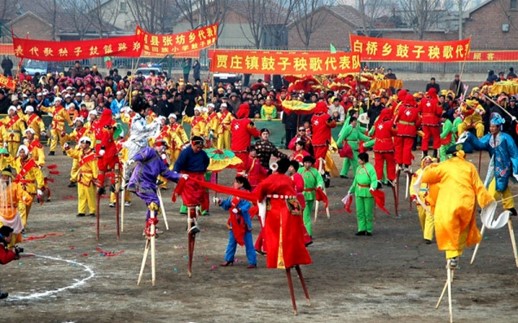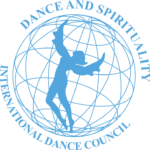China
List Of Dances
![]() Monlam Festival (Cham) Tibet
Monlam Festival (Cham) Tibet
* QingMing Festival China
![]() Shana (Cham) Bhutan
Shana (Cham) Bhutan
![]() Sleeves Dance China
Sleeves Dance China
![]() Yangko Drum China
Yangko Drum China
![]() Yangko NorthEast China
Yangko NorthEast China
![]() HUA GU DENG – Anhui China
HUA GU DENG – Anhui China
DEBATE DANCE

REFERENCE : China Tibet Online (website)
Read the full article
See also
“Spiritualities/buddhism” in this site
CHINA
Region: TIBET
Ethnic group : Tibetan
Spirituality: Tibetan Buddhism
The debate of Tibetan Buddhist Buddhist monks is a unique means of learning, and also forms an important basis for obtaining a diploma by monks in Tibetan Buddhism, dating back over a thousand years of history.
In the Rab Monastery in Yushu Tibetan Autonomous Prefecture in Qinghai Province, nearly 100 Buddhist monks in purple robes are seated in groups in the courtyard in the middle of a monastery. In each group, someone is standing and asking questions, and then he hits the left palm with his right hand to the sky, which means that another crucial moment has arrived. Another person sits on the side and answers the question. In intense debates, we often hear people clapping, we see movements of the legs, these are the external signs of the collision of intense ideas.
North East YangKo

AUTHOR : Zhang Dace
Read the full text
See the video
Thanks to Mr LI HAIBING for organising the collection of the informations
CHINA
Region: Northeast China (Jilin Province, Heilongjiang Province and Liaoning Province)
Ethnic group : Han, Manchu, Hui
Spirituality: Traditional
Origin time: Although the specific time is difficult to verify, it is generally believed that it originated in the Ming and Qing Dynasties.
Function: Celebrate harvest, pray and sacrifice.
Dance features: humorous, bold, provocative and humorous.
Dance roles: head-stilts, second stilts, old beards and colorful women, tops, bottoms, fishermen and fishermen, and opera figures.
Dance props: fans, handkerchiefs, stilts, ribbons, etc.
Dance costumes: based on traditional Han costumes, costumes are brightly colored and decorative, such as red flowers, green pants and embroidered shoes.
The dance accompaniment band consists of big drum, big cymbal, small cymbals, gong, suona and so on.
Drum YangKo

AUTHOR : Professor Yue Yin
Read the full text
See the video
Thanks to Mr LI HAIBING for organising the collection of the informations
CHINA
Region: Central Shandong Province (represented by places like Shanghe)
Ethnic Groups: Han
Spirituality: Traditional
Origin Time: It originated at the end of the Song Dynasty and the beginning of the Yuan Dynasty and developed during the Ming and Qing Dynasties.
Functions: Sacrificial rituals for wishes, festival celebrations, and entertaining the public.
Dance Characteristics: Grand and imposing, vigorous and powerful, with bold and unrestrained movements full of masculine strength.
Dance Roles: Umbrella – leaders, drummers, club – wielders, flower – maidens, clowns, etc. Among them, the umbrella – leaders are the core of the team, guiding the rhythm and formation changes of the dance.
Dance Props: Flower umbrellas, drums, drumsticks, hand gongs, etc.
Dance Costumes: Based on traditional costumes, with bright colors. Men’s costumes are mostly short – sleeved and narrow – sleeved for easy movement; women’s costumes are more flowing, adding a sense of agility.
Accompanying Band: Composed of big drums, gongs, cymbals, suona horns, etc. The music has a lively rhythm, setting off a warm atmosphere.
Meaning The drum yangko expresses the quest for strength and has four “core elements”-stability, heaviness, tenacity.
HUA GU DENG - ANHUI

AUTHOR : Mme Ping Li
Read the full text
See Video 1
See Video 2
Thanks to Mr LI HAIBING for organising the collection of the informations
CHINA
Region: Huaiyuan, Fengtai and other places along the Huai River in Anhui Province
Ethnic Group: Han
Spirituality: Traditional
Origin Time: It originated in the Xia and Shang dynasties and gradually matured during the Ming and Qing dynasties.
Functions: Celebrating harvests, praying for blessings and eliminating disasters, and providing cultural entertainment.
Dance Characteristics: The movements are light and graceful, with a brisk and lively rhythm. It combines hardness and softness, integrating the boldness of northern dances and the delicacy of southern dances.
Dance Roles: Mainly include umbrella – holders, drum – players, and “orchids”. The roles are clearly divided and the coordination is tacit.
Dance Props: Flower drums, big gongs, small gongs, cymbals, handkerchiefs, fans, etc.
Dance Costumes: Bright – colored. Men’s costumes are mostly short – styled, highlighting competence; women’s costumes mainly consist of flowing long skirts with exquisite decorations.
Accompanying Band: Composed of percussion instruments such as flower drums, gongs, and cymbals, as well as wind instruments like suona horns. The melodies are full of local characteristics.
.
